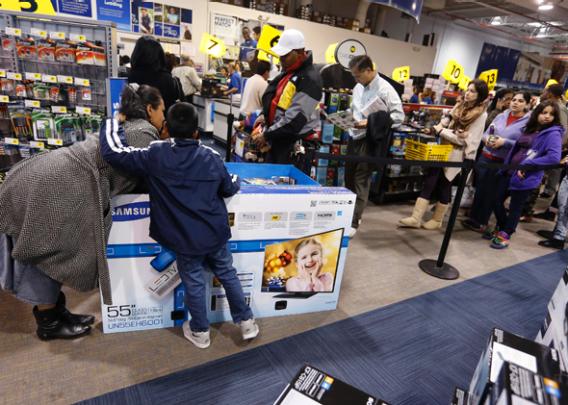Why Best Buy Needs To Die

The Article: The Good News Is That They Saved Best Buy by Matthew Yglesias in Slate.
The Text: Best Buy is having a moment. Many observers wrote off the retail electronics chain as Circuit City and Borders liquidated and Barnes & Noble shrank. But in August of last year, French executive Hubert Joly resigned his post with travel management company Carlson to try to turn Best Buy around. By many measures, he seems to be succeeding. The price of Best Buy stock has more than tripled from its $11 low point in December. Costs are down, profits are up, and people are excited about their vending machines. But cutting costs alone isn’t a strategy for a company to thrive. Has Joly actually made the store any good? Is it a place you could recommend that people go to shop? Are the buys the best?
I rode the bus to the store’s Columbia Heights location in Washington, D.C., on Thursday morning to investigate. Intrepid Slate intern Dan Gartland visited the Noho location in New York for more data. My conclusion—Best Buy still basically sucks. It doesn’t have the best prices, it doesn’t have the best selection, and it doesn’t succeed on the level of customer service.
Having assembled a semi-arbitrary shopping list of items (a blend of Wirecutter recommendations, stuff I’d bought recently from Amazon, and things my Twitter followers suggested), the best bargain I found wasn’t on the list. A woman speaking hesitant English asked me if I was in the store to buy something. I said, “Sure.” She gestured toward her friend and explained that she had a store card with a $42.39 credit from a return. But she didn’t want store credit. Would I be interested in buying the card off of her? I forked over 40 bucks, leaving me with a tidy profit.
The problem is that actually buying stuff at Best Buy often involves taking a bath. I saw a 32-gigabyte USB thumb drive from PNY for $49.99, I found out that it is selling for less than $30. In New York, Gartland found a SanDisk Cruzer model for $24.99, but Amazon has it for just over $20. The Wirecutter recommends Vizio’s 32-inch E320i-A0 as the best small television on the market. Amazon has it for about $290, while both the New York and Washington stores are asking $379.99. The KitchenAid Artisan Stand Mixer they were selling in DC for $349 is on Amazon for about $310.
Not every price is bad, but the best bargains at Best Buy are really for things that are intrinsically scammy. Apple charges $19 for its first-party Lightning cables, and that’s exactly what they cost at Best Buy. You can get a cheaper Lightning cable from Amazon, but not an official Apple-branded one. By the same token, with Microsoft set to ship its Xbox One game console in November, now would be a very odd time to buy an Xbox 360 console. But if you do want one, Best Buy has a good price to offer. The store also matched Amazon’s price on the Wirecutter-recommended Yamaha RX-V373 5.1-channel stereo receiver.
But where the store truly fails is as a store. Not everything in life is about bargains. It could make perfect sense to pay a premium in exchange for a useful customer service experience. To put this to the test, I wandered over to the home theater section and told a sales rep that I needed to pick up an HDMI cable. These connector cables are the locus of notorious markups and sales scams. To make a long story short, all HDMI cables are good enough, but many brands gouge customers with premium prices and bogus claims of quality. Best Buy’s guy was very much part of the con. He offered me three levels of cable quality for a 6-foot HDMI. The “cheap” $19.99 cable (Amazon has one for about $6), a superior $39.99 cable, and high-end “high-speed” cable from Monster for $59.99. Just to be clear, I asked the salesman if the more expensive cable was really better. He assured me that it was, that if you really want to make sure you’re getting the best from your Blu-ray player, for example, you need that high-end cable. To his credit, he didn’t push me when I declined. But this is malpractice verging on fraud.
Amazon, to its discredit, also sells this crap. But the big question for brick-and-mortar retail is how it can deploy the physical presence of human beings to generate value. For Best Buy the answer seems to be scams. Eavesdropping on other customers, salesman after salesman was trying to upsell people on service plans or warranties or reminding them that they might want to buy screen-cleaning wipes.
Back in April 2012, Farhad Manjoo argued that to save itself Best Buy needed to start stocking fewer items, thereby playing more of a curatorial role and helping its staff become real product experts. It’s a great idea for a store. But for this store? To do it would require a real philosophical transformation, whereby the role of Best Buy and its blue-shirts would be to help customers, not just talk them into high-margin add-ons.
Under the circumstances, it’s not surprising that Joly didn’t take Manjoo’s advice. What is a bit surprising is how successful he’s been at reviving the company’s fortunes without making dramatic changes. I’m a little skeptical it will work in the long term—competing with online retail on the basis of hustling your customers isn’t much of a value proposition—and I’m a lot skeptical that I want it to work. A year ago, Best Buy looked to be headed for a well-deserved death. Today, it seems to have escaped that fate without doing anything to deserve its good fortune.









